1.5. Use as aquafeed
Several feeding trials have been carried out to evaluate algae as fish feed. Algae have been used fresh as a whole diet and dried algal meal has been used as a partial or complete replacement of fishmeal protein in pelleted diets.
1.5.1 Algae as major dietary ingredients
A summary of the results of selected growth studies on the use of fresh algae or dry algae meals as major dietary ingredients for various fish species and one marine shrimp is presented in Table 1.2. Dietary inclusion levels in these studies varied from 5 to 100 percent. Fishmeal-based dry pellets or moist diets were used as control diets.
The results of the earlier growth studies showed that the performances of fish fed diets containing 10–20 percent algae or seaweed meal were similar to those fed fishmeal based standard control diet. The responses were apparently similar for most of the fish species tested. These inclusion levels effectively supplied only about 3–5 percent protein of the control diet. In most cases, these control diets contained about 26–47 percent crude protein.
This shows that only about 10–15 percent of dietary protein requirement can be met by algae without compromising growth and food utilization. There was a progressive decrease in fish performance when dietary incorporation of algal meal rose above 15–20 percent. However, although reduced growth responses were recorded with increasing inclusion of algae in the diet, the results of feeding trials with filamentous green algae for O. niloticus and T. zillii indicated that SGR of 60–80 percent of the control diet could be achieved with dietary inclusion levels as high as 50–70 percent.
Recent work by Kalla et al. (2008) appears to indicate that the addition of Porphyra spheroplasts to a semi-purified red seabream diet improved SGR. In addition, Valente et al. (2006) recorded improvements in SGR when dried Gracilaria busra-pastonis replaced 5 or 10 percent of a fish protein hydrolysate diet for European seabass.
Table 1.1
Chemical analyses of some common algae and seaweeds
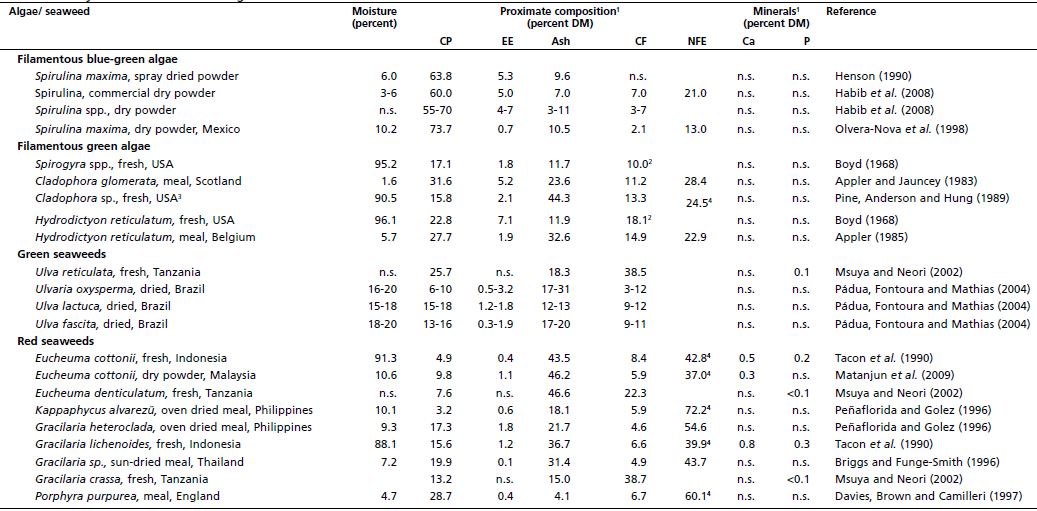
1 DM = dry matter; CP = crude protein; EE = ether extract; CF = crude fibre; NFE = nitrogen free extract; Ca = calcium; P = phosphorus
2 Cellulose
3 Mean of proximate composition values of algae collected from flowing and static water
4 Adjusted or calculated; not as cited in original publication
TABLE 1.2
Performance of various fish species fed fresh algae or dried algal meal
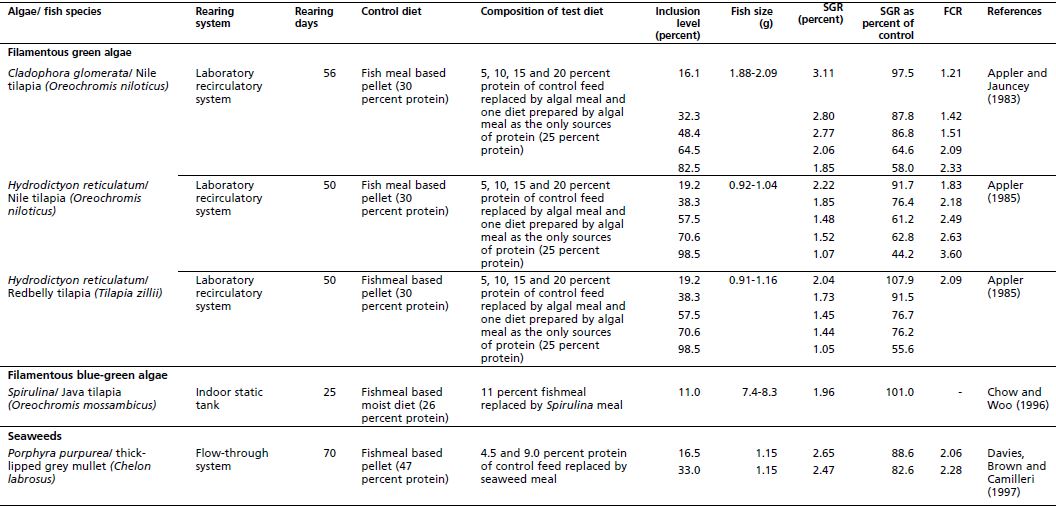
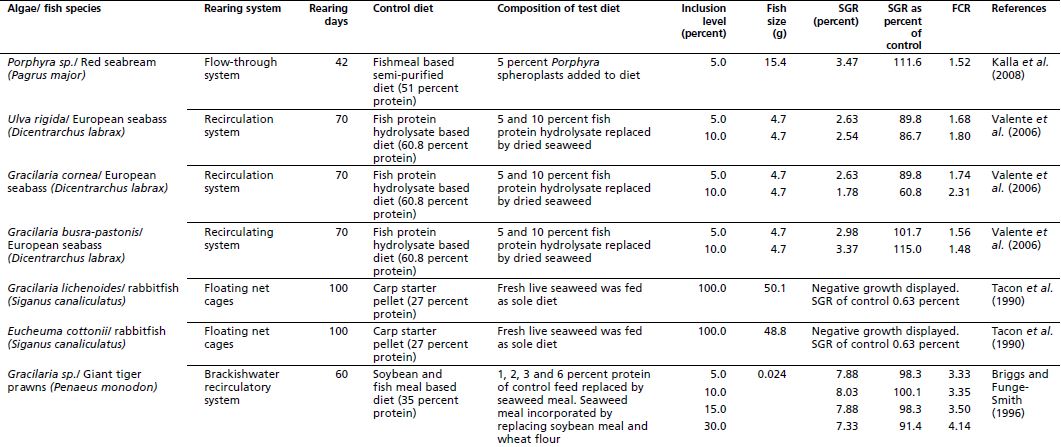
Table 1.3
Results of investigations on the use of algae as additives in fish feed
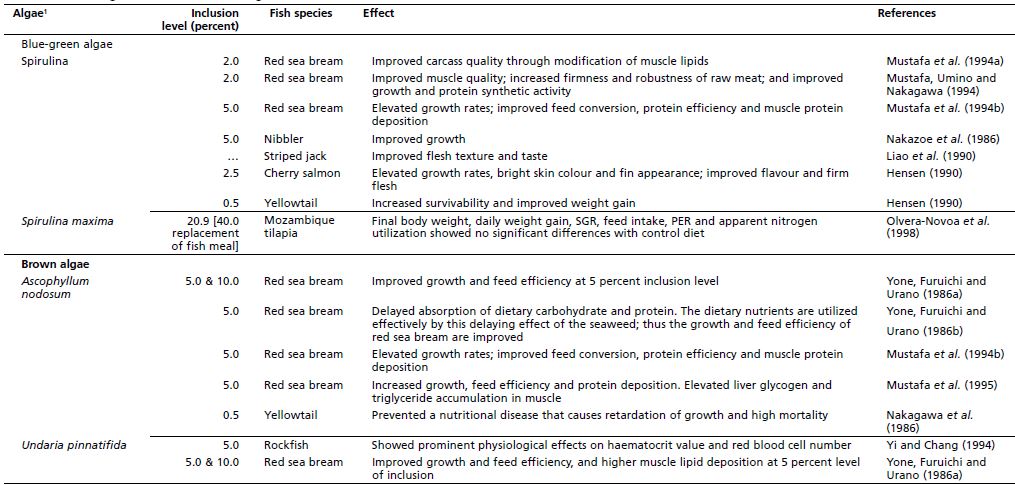
TABLE 1.3 (cont.)
Results of investigations on the use of algae as additives in fish feed
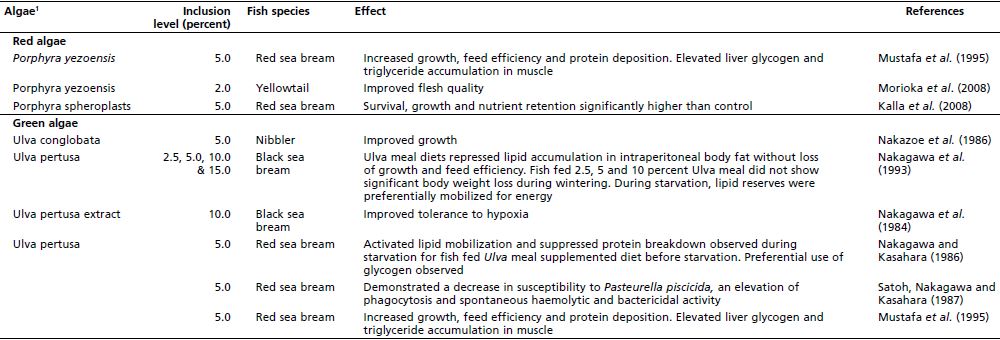
1 Algae were added as dried meal in all diets except otherwise stated
However, the conclusions of the latter authors are confused by the fact that the test diets were not iso-nitrogenous with the control diet; in fact test diets had a lower protein level.
Total replacement of fishmeal by algal meal showed very poor growth responses for O. niloticus (Appler and Jauncey, 1983; Appler, 1985) and T. zillii (Appler, 1985). Appler and Jauncey (1983) recorded a SGR of 58 percent of control diet when the filamentous green alga (Cladophora glomerata) meal was used as the sole source of protein for Nile tilapia. Similarly, Appler (1985) recorded SGRs of 44 percent and 56 percent of control diets when the filamentous green alga (Hydrodictyon reticulatum) meal was used as the sole source of protein for O. niloticus and T. zillii.
Tacon et al. (1990) used fresh live seaweeds (Gracilaria lichenoides and Eucheuma cottonii) as the total diet for rabbitfish in net cages. In both cases negative growth was displayed, although the daily feed intake was more than the control diet. On a dry matter basis, the daily feed intake was 1.99 and 1.98 g/fish/day respectively for E. cottonii and G. lichenoides, while the feed intake for carp pellets (control diet) was 1.80 g/fish/day. Apparently, a good feeding response was observed for both the seaweeds but very poor feed efficiency was displayed. Apart from commonly observed impaired growth, the use of algae as the sole source of protein in fish feed can also result in malformation (Meske and Pfeffer, 1978).
The apparently poor performance of fish fed diets containing higher inclusion levels of algae may be attributable to several factors. Appler (1985) observed that most of the aquatic plants including algae contain 40 percent or more of carbohydrate, of which only a small fraction consists of mono- and di-saccharides. Low digestibility of plant materials has been attributed to a preponderance of complex and structural carbohydrates. The poor digestibility and the subsequent poor levels of utilization obtained for both tilapia species with increased dietary algal levels may thus be attributable in part to the presence of indigestible algal materials. Pantastico, Baldia and Reyes (1985) reported that newly hatched Nile tilapia fry (mean weight 0.7 mg) did not survive at all when unialgal cultures of Euglena elongata and Chlorella ellipsoidea were fed to them. These authors concluded that the mortality of tilapia fry might be due to factors such as toxicity and cell-wall composition of the algae fed. This phenomenon might also be attributed to poor digestion of plant material by the less developed digestive system of newly hatched larva. In contrast, Chow and Woo (1990) recorded significantly higher gut cellulase activity in O. mossambicus fed Spirulina, indicating the ability of this tilapia species to digest cellulose, the main constituent of plant cell walls. Ayyappan et al. (1991) conducted a Spirulina feeding experiment with carp species. The fry stage of catla (Catla catla), rohu (Labeo rohita), mrigal (Cirrhinus mrigala), silver carp (Hypophthalmicthys molitrix), grass carp (Ctenopharyngodon idella) and common carp (Cyprinus carpio) were fed with an experimental diet in which 10 percent dried Spirulina powder was added to a 45:45 mixture of rice bran and groundnut oil cake. A 50:50 bran-groundnut oil cake control diet was used. The mean specific growth rates of fish fed on the two diets were: catla 0.17, 0.27; rohu 0.19, 0.63; mrigal 0.54, 0.73; grass carp 0.02, 0.40; and common carp 0.15, 0.20; with significant differences between the treatments (F1,4 = 8.88; P < 0.05) and fish species (F4,4 = 5.03; P < 0.10). Rohu and mrigal showed significantly (P < 0.05) higher SGRs than catla and common carp. These results clearly demonstrated the beneficial effect of the Spirulina diet on the yield and quality of carp fry.
Dietary supplementation of Chlorella ellipsoidea powder at 2 percent on a dry weight basis showed higher weight gain and improved feed efficiency and protein efficiency ratios in juvenile Japanese flounders (Paralichthys olivaceus); the addition of Chlorella had positive effects as it significantly reduced serum cholesterol and body fat levels and also led to improved lipid metabolism (Kim et al., 2002).
Clearly, no definite conclusions can be arrived at this stage about the value of using macroalgae as major dietary ingredients or protein sources in aquafeeds. Moderate growth responses and good food utilization (FCR 1.5–2.0) were generally recorded when dried algal meal were used as a partial replacement of fishmeal protein. However, the collection, drying and pelletization of algae require considerable time and effort. Furthermore, cultivation costs would have to be taken into consideration. Therefore, further cost-benefit on-farm trials that take these costs into consideration are needed before any definite conclusions on the future application of algae as fish feed can be drawn.
1.5.2 Algae as feed additives
The main applications of microalgae for aquaculture are associated with nutrition, being used fresh (as sole component or as food additive to basic nutrients) for colouring the flesh of salmonids and for inducing other biological activities (Muller Feuga, 2004). Several investigations have been carried out on the use of algae as additives in fish feed. Feeding trials were carried out with many fish species, most commonly red sea bream (Pagrus major), ayu (Plecoglossus altivelis), nibbler (Girella punctata), striped jack (Pseudoceranx dentex), cherry salmon (Oncorhynchus masou), yellowtail (Seriola quinqueradiata), black sea bream (Acanthopagrus schlegeli), rainbow trout (Oncorhynchus mykiss), rockfish (Sebastes schlegeli) and Japanese flounder (Paralichthys olivaceus). Various types of algae were used; the most extensively studied ones have been the blue-green algae Spirulina and Chlorella; the brown algae Ascophyllum, Laminaria
and Undaria; the red alga Porphyra; and the green alga Ulva. Fagbenro (1990) predicted that the incidence of cellulase activity could be responsible for the capacity of the catfish Clarias isherencies to digest large quantities of Cyanophyceae.
A summary of the results of selected feeding trials with algae as feed additives is presented in Table 1.3. Most of these research studies were conducted in Japan with Japanese fish species, although the results may well be applicable to other species and in other countries.
Table 1.3 shows that dried algal meals or their extracts have been added to test fish diets at levels up to 21 percent level. The responses of test fish fed algae supplemented diets were compared with fish fed standard control diets. Although various types of algae and fish species were used in these evaluations, not all algae were evaluated as feed additives for every different species. As the main biochemical constituents and digestibility are different among algae, the effect of dietary algae varies with the algae and fish species (Mustafa and Nakagawa, 1995). While studying the effect of two seaweeds (Undaria pinnatifida and Ascophyllum nodosum) at different supplementation levels for red sea bream, Yone, Furuichi and Urano (1986a) observed best growth and feed efficiency from a diet containing 5 percent U. pinnatifida followed by a diet containing 5 percent A. nodosum. Similarly, Mustafa et al. (1994b) observed more pronounced effects on growth and feed utilization of red sea bream by feeding a diet containing Spirulina compared to one containing Ascophyllum. In another study, Mustafa et al. (1995) studied the comparative efficacy of three different algae (Ascophyllum nodosum, Porphyra yezoensis and Ulva pertusa) for red sea bream and noted that feeding Porphyra showed the most pronounced effects on growth and energy accumulation, followed by Ascophyllum and Ulva. However, research results obtained so far do not specifically identify any specific algae as the most suitable as feed additives for any particular fish species.
Nevertheless, the results of various research studies show that algae as dietary additives contribute to an increase in growth and feed utilization of cultured fish due to efficacious assimilation of dietary protein, improvement in physiological activity, stress response, starvation tolerance, disease resistance and carcass quality. In fish fed algae-supplemented diets, accumulation of lipid reserves was generally well controlled and the reserved lipids were mobilized to energy prior to muscle protein degradation in response to energy requirements. In complete pelleted diets, algal supplementation of 5 percent or less was found to be adequate.
Spirulina are widely used as feed additives in the Japanese fish farming industry. Henson (1990) reported that Spirulina improved the performances of ayu, cherry salmon, sea bream, mackerel, yellowtail and koi carp. The levels of supplementation used by Japanese farmers are 0.5-2.5 percent. Henson (1990) further reported that Japanese fish farmers used about US$2.5 million worth of Spirulina in 1989. Five important benefits reported by using a feed containing this alga were improved growth rates; improved carcass quality and colouration; higher survival rates; reduced requirement for medication; and reduced wastes in effluents. However, the high cost of most of these algae may limit their use to the commercial production of high value fish only.